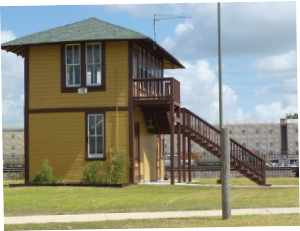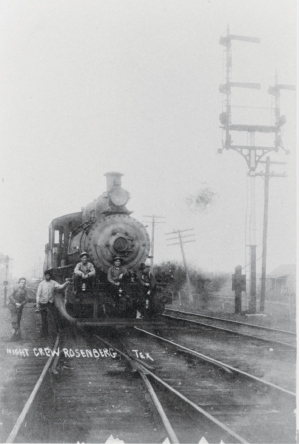
The Rosenberg Railroad Museum Gallery is
a reproduction of the Rosenberg Santa Fe Depot with the 1972 MoPac Caboose in the background.
A LITTLE PIECE OF HISTORY | By Joan Frances –
There are events in the history of Fort Bend County that are considered pivotal to its growth and expansion. Stephen F. Austin and the Old Three Hundred settlers were the first to see the value in the area’s terrain and climate, and they initiated farming and ranching. Despite contending with Native Americans, wild animals and the weather, the settlers did not give up. When railroads were built through the small towns, prosperity commenced. Transportation of passengers, gold bullion, silver, animals and crops enabled commerce from city to city. For over 129 years, the railroad has been a driving force behind Rosenberg’s growth, and the Rosenberg Railroad Museum is a tribute to its magnitude.

The Rosenberg Railroad Museum’s Tower 17 is the only building that was a part of the original railroad structure.
In 1883, Henry Von Rosenberg, a Swiss immigrant and the first president of the Gulf, Colorado and Santa Fe Railway (GC&SF), founded the city after his name. In 1873, Rosenberg and the Sealy brothers made plans to build the railroad, bypassing the Houston route and extending to Temple, Texas. The City of Richmond already had the Galveston, Harrisburg and San Antonio Railroad serving the town, so the GC&SF engineers laid the track one mile from the courthouse to avoid the town proper.
By 1880, the railroad had expanded to the Rosenberg Junction, a depot was built, and this small town began to grow. In 1883, the railroad bought and platted a 200 acre site with a central square between the Brazos River and the railroad. In 1882, the New York, Texas and Mexican Railway was orchestrated by Count Joseph Telfener, an Italian investor and engineer, who was given liberal land grants that the state offered to encourage railroad construction. Nicknamed the “Macaroni Line” because of the pasta diet of the Italian laborers, they completed 91 miles of track to Victoria. As a result of these railroads, Rosenberg became a center for trade and commerce.
In 1992, a group of insightful Rosenberg citizens took an interest in preserving Fort Bend County’s railroad history. In 1993, committee chairman Judge Larry Wagenbach persuaded the Atchison, Topeka and Santa Fe Railway Company to donate 1.47 acres of land for the purpose of building the Rosenberg Railroad Museum. Later that year, the first artifact was purchased from an auction at George Ranch, an 1879 business railcar named Quebec. None of Rosenberg’s original railroad structures survived except for Tower 17, which was still in service. Several fundraisers were held in an effort to financially prepare for the museum’s building structure, foundation and restoration of the railcar.

Night crew of a train in Rosenberg. Photo from Historic Fort Bend County.
By 1998, construction began on the museum modeled after the original Rosenberg depot that served the Santa Fe and Southern Pacific Railroads from 1883 to 1917. Rosenberg residents gathered relics such as maps, photographs, lanterns, railroad tickets, badges, tools, locks and keys, brochures, timetables and vintage furniture. The community generously donated these items to the museum in an effort to preserve the memories of the past for the public to see.
Thousands of patrons from all over Fort Bend County celebrated the Museum’s Grand Opening June 6 through 8, 2002. A tour began in the depot with a short film, followed by a walk down memory lane as visitors viewed cases of memorabilia, the outside rail car, caboose and finally, a detailed miniature railroad system.
With so much to offer the community, the Rosenberg Railroad Museum continues to host festivals in conjunction with Rosenberg’s Historic Downtown District to educate the public and preserve Rosenberg’s history. Located at 1921 Avenue F, the museum is open Wednesday through Saturday from 10 am to 5 pm and Sunday from 1 to 5 pm. For more information, visit www.rosenbergrrmuseum.org or call 281-633-2846.